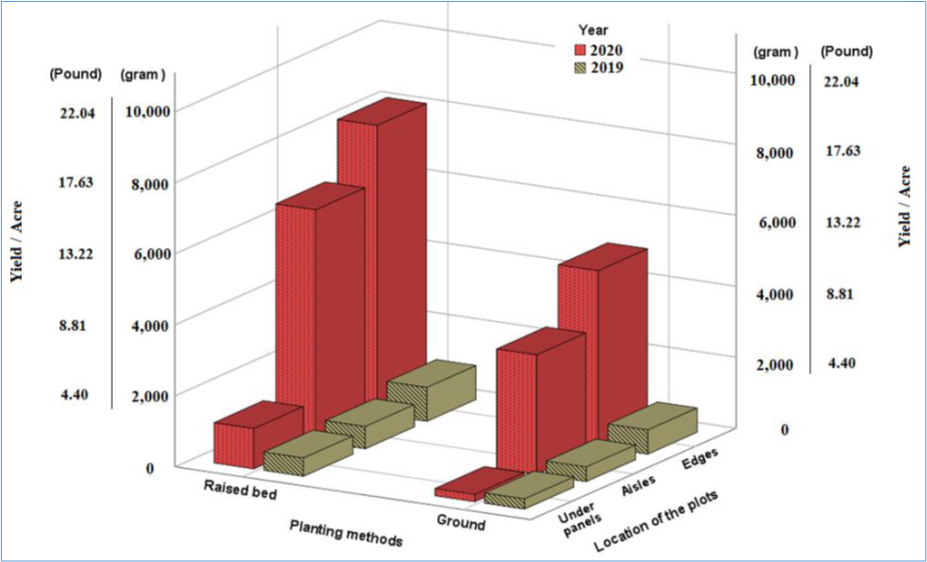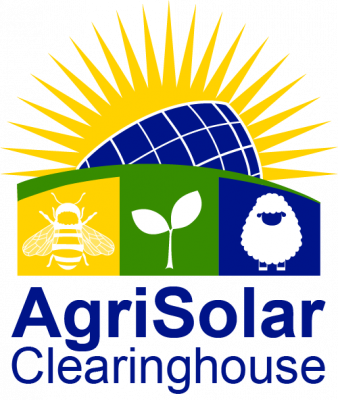This fact sheet provides tips, facts, and guidance on a variety of agrivoltaic-related practices for solar projects and native vegetation in Iowa. The fact sheet includes information on how to add product value, planning, cost, seeding, management, and construction. The resource also provides examples of native seed mixes for the region of Iowa. Also included in this fact sheet are a short summary of best practices for agrivoltaic operations in Iowa.
Tag Archive for: Agrivoltaics
This report explores the synergies between farming and solar photovoltaics with the premises that agricultural production on farmland should be maintained and farm profitability and soil health should be improved. This report explores whether a strong case can be made from a public policy point-of-view for developing solar so that it helps to preserve and improve farmland and the ecosystem in which it is located, while enabling achievement of both energy system and food system goals. The report covers many topics related to agrivoltaic systems including soil health, loss of land to development and electricity and agricultural land context.
This study addresses how land is being converted to accommodate for solar farms, and the potential for pollinator habitat to be established at solar farms in North Carolina. This report reveals that, based on previous land use, alternative vegetation selection, and cost comparison with current vegetation management techniques, the potential to create pollinator habitat at solar farms in North Carolina is likely to be feasible. The report covers suggested vegetation, estimated land-use acreage and cost analysis for agrivoltaic operations in North Carolina.
Starting in 2019, insect inventories were collected from a solar facility in Jackson County, Oregon as part of a study on plant-pollinator interactions in agrivoltaic systems. This study investigated the effects of solar arrays on plant composition, bloom timing and foraging behavior of pollinators in open fields, and in full shade and partial shade areas under solar panels in a predominant agricultural region of southern Oregon. The report shows that typically unused ground under solar panels can be used for pollinator habitat that benefits pollinating insects.
The Electric Power Research Institute (EPRI) worked with the Xerces Society for Invertebrate Conservation to develop this report, which synthesizes the scientific literature and existing best management practices for monarch butterflies, along with input from a survey of monarch experts and a survey of EPRI members. This technical report includes details surrounding herbicide use, controlling invasive species, brush and tree management, mowing, prescribed fire, grazing, and restoration and revegetation. Also presented is that it is important to consider the specific land asset type in relation to supporting monarchs, including transmission lines, distribution lines, power plant sites, surplus properties, solar sites, wind sites, and substations.
This paper highlights and discuss ongoing efforts to couple solar energy production with pollinator conservation, noting recent legal definitions of these practices. It also summarizes key studies from the field of ecology, bee conservation, and the author’s experience working with members of the solar industry. The paper specifically addresses how solar facilities are designed and spread to the public and highlights ongoing efforts to couple solar energy production with preservation of pollinators and their habitat. Other details in this paper focus on native, perennial flowering and their association with the sustainability of beekeeping and bee preservation.
This summary provides a comprehensive overview of bird mortality patterns in utility scale photovoltaic solar. It synthesizes results from fatality monitoring studies at 10 photovoltaic solar facilities across 13 site years in California and Nevada. The report also addresses vegetation that is often removed in regions such as deserts in the southwestern U.S. However, the benefits of site restoration to pollinators and other wildlife have been recently recognized and developers in some regions of the U.S. are moving towards ecologically-based site restoration and low impact site restoration.
Recent research conducted on a Minnesota agrisolar operation showed that grazing sheep at ground-mounted solar projects improves the health and quality of the soil and that consecutive annual grazing treatments to land under solar panels realized more benefits than intermittently grazed land.
The MNL Conservation Grazing Program’s flock of sheep has been grazing under the solar panels of Enel’s 150 MWdc Aurora Solar operation since 2017. The research studied the impacts of sheep grazing on six separate solar PV sites compared to undisturbed control sites.
Soil samples taken in 2020 from six locations were compared to soil samples taken in 2021, revealing a variety of benefits in soil health related to micro and macro nutrients and soil grain size distribution. Managed sheep grazing significantly increased the total carbon storage (10 to 80%) and available nutrients of the soil.
MNL’s solar grazing manger stated that,” More solar means more opportunities for new farmers to get started in the industry. We consult with solar projects throughout the Midwest and the concept of grazing sheep on a solar projects opens the door for new shepherds who may lack easy access to grazing land to get started,” according to a media report by Solar Power World.
The research was made possible through the partnership of MNL, Enel Energy, Temple University, and the National Renewable Energy Laboratory (NREL), which also highlighted other potential benefits aside from things like macro and micronutrients in the soil, such as water quality, stormwater control, and healthy pollinator habitat.
Read more about the research here.
As a supporting organization of EUCI’s upcoming Solar Agrivoltaics Essentials event, March 23-24, the National Center for Appropriate Technology is pleased to extend a 10% discount off the registration price to you and your colleagues.
The widespread adoption and development of solar across a nearly full range of landscapes, topographies and geographies has triggered multiple “dual use” innovations. Among the most promising of these is agrivoltaics: the co-location of solar with natural resource practices broadly characterized as agriculture.
Attendees will gain practical skills and insights on how to:
- Review the research, pilot projects and best practices that best inform those considering agrivoltaic projects
- Identify the Ag practices that can be co-located with solar project development, as well as their potential outcomes
- Estimate cost vs benefits (LCOE) co-locating agricultural practices with solar projects
- Examine case studies of agrivoltaics projects from the perspective of project sponsors, developers, lenders, EPCs and OEM suppliers
Use discount code AGR0322NCAT at registration to receive 10% off the standard registration rate.
Please visit the EUCI website for more information!
The North American Center for Saffron Research and Development is conducting a multi-year study of saffron crops grown under and adjacent to ground-mounted solar arrays. The study, which began in 2015, includes two years of field data from the iSun solar field (formerly Peak Electric) in Burlington, Vermont.
Researchers established the saffron corms in three locations within the solar field: in the aisles; directly under the solar panels; and around the perimeter of the arrays. These three locations include both raised beds and in-ground planting methods.
Saffron is a perennial crop suitable for sunny locations in arid and semi-arid regions. It is relatively resistant to cold. Yields typically increase for three years after planting, often increasing exponentially between the second and third years. Saffron is a high-value crop, with values ranging from $19-$55/gram retail. It is also a hand-harvested crop, making it well-suited for agrivoltaics.
In the first year of the field trial, the saffron yield was low, as expected for newly planted saffron corms, with a higher yield in the raised bed plots. The second year of the trial produced higher-than-average yields, with some plots producing yields three times higher –than averages.
Highest yields occurred in the lots located in the aisle and around the perimeter of the solar panels, with yields of 17 pounds of saffron/acre, which would be equal to $192,775/acre at an average price of $25/gram.
The plots directly under the solar panels did not show this increase in production. These plots showed a 30% decrease in yield, indicating that the area under the panels is not an ideal micro climate for saffron production. Figure 1 shows the average yield of the harvested saffron per acre during the field trial.

Figure 1. Average yield of harvested saffron per acre during 2019 and 2020. (Ghalehgolabbehbahani et al., 2022)
Research will continue at this facility and the AgriSolar Clearinghouse will plan a field trip for the public in the fall of 2022. The annual report for this study is available in the Information Library here.
Reference
Ghalehgolabbehbahani et al., 2022. Saffron and Solar Farms: A Win/Win for Environment and Agriculture. North American Center for Saffron Research and Development, Burlington VT.
